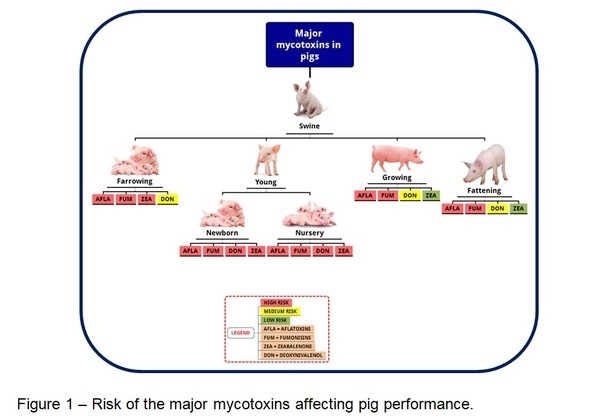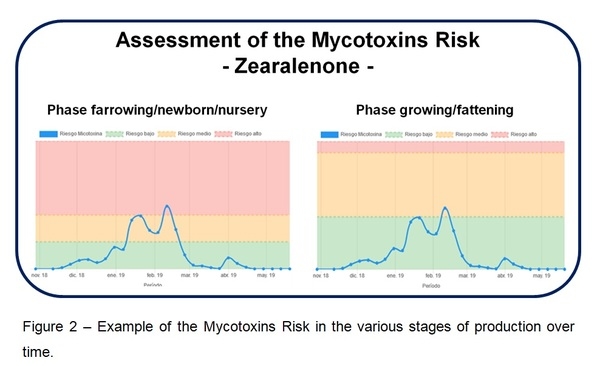Mycotoxins Risk as a Management Tool in Swine Industry
Published: June 19, 2019
Source : Denize Tyska 1, Adriano Olnei Mallmann 2 / 1 Zootechnist, MSc., Director of Research & Development, Pegasus Science; 2 Veterinarian, PhD., Technical Director, Pegasus Science.
Brazil occupies an important position in the world ranking of pork production, both as producer and exporter, behind only China, the European Union and the United States. Such growth is due to varied factors, such as genetics, management, sanitation and nutrition. All this care has made pork very attractive and pleasing to the palate, thus opening up new markets. Rations are intensively used within this production chain, accounting for about 70 to 80% of the total cost. Thus, quality of the raw materials must be guaranteed, as this can, in addition to costs, represent losses in terms of productivity.
As in other areas, the existence of fungi in grains used in the nutrition of pigs, especially in maize, causes losses in energy levels; there is a reduction in nutritional value, in addition to the possibility of mycotoxins production. Swine is very sensitive to intoxications by mycotoxins. The main mycotoxins which affect these animals are aflatoxins, produced by fungi of the genus Aspergillus, and fumonisins, zearalenone and trichothecenes, which are produced by fungi of the genus Fusarium.
Aflatoxins (B1, B2, G1 and G2) cause a number of toxic effects in animals, with pigs being particularly sensitive. The clinical signs and severity of aflatoxicosis outbreaks may vary with the age of the animals; the younger ones are more sensitive.
Other variants are the type of aflatoxin (B1 is admittedly the most toxic), the composition of the diet, the time of exposure and the dose ingested.
Acute aflatoxicosis is easily observed by hepatic lesions followed by depression, anorexia, jaundice, and hemorrhages. In the most acute cases, in turn, the clinical signs are evident within a few hours and lead the animal rapidly to death. However, subclinical disease is the most damaging; the animal ingests low doses of the toxin in a constant way, which determines changes in the productive parameters.
Other variants are the type of aflatoxin (B1 is admittedly the most toxic), the composition of the diet, the time of exposure and the dose ingested.
Acute aflatoxicosis is easily observed by hepatic lesions followed by depression, anorexia, jaundice, and hemorrhages. In the most acute cases, in turn, the clinical signs are evident within a few hours and lead the animal rapidly to death. However, subclinical disease is the most damaging; the animal ingests low doses of the toxin in a constant way, which determines changes in the productive parameters.
Zearalenone is a very important mycotoxin for the swine species, because it causes several reproductive disorders. The mycotoxin or its metabolites cause hyperestrogenism by promoting the stimulation of cytoplasmic estrogen receptors, increasing protein synthesis in the reproductive system. Consequently, secretion of endometrial cells, synthesis of uterine proteins and size of the reproductive tract are increased. Such deformations can lead to pseudopregnancy due to maintenance of corpus luteum, and to birth of weak and stillborn piglets; the splay leg syndrome may often happen. There may also be a marked reduction in conception rates, accompanied by estrus repetition.
The pigs also present high sensitivity to fumonisins. The main target organs are lung, heart and liver, and the specific syndrome in this species is the Porcine Pulmonary Edema, usually with hydrothorax. These clinical signs are common in acute intoxications, when the animal ingests high doses of the toxin in a short period of time. However, chronic intoxications are the most frequent and occur as a result of hepatic and intestinal lesions, determining the appearance of poor general condition. In these cases, the animals in a lot normally exhibit significant disparity. Food intake is reduced, thus causing a lower weight gain. In addition, the pigs’ bristles are less bright and bristly, and the animals move more frequently in the pen when feeding. This toxin can cause immunosuppressive effects such as reduction of the concentration of macrophages in the lungs of the pigs, predisposing them to respiratory diseases.
Another important group of mycotoxins is that of trichothecenes, whose main feature is its immunosuppressive effect. Pigs show a high sensitivity to these toxins. The main mechanism of action occurs by inhibition of protein synthesis and interference in the synthesis of DNA and RNA, reaching cells with high metabolic capacity and active multiplication. Within this group, the one of greater toxicological and economic importance for the swine industry is deoxinivalenol. Other important toxins are diacetoxyscirpenol, T-2 toxins and nivalenol; although with significant effects, they have a low prevalence in the raw materials routinely used to produce feed. Figure 1 illustrates the major mycotoxins that affect pig performance, along with the level of risk each one represents.

Another factor well discussed is the occurrence of multiple toxins and, therefore, several preventive actions must be carried out. The decision, for example, whether or not to use an antimycotoxins additive, as well as the inclusion dosage, should be made based on the assessment of the Mycotoxins Risk. This management is carried out by means of constant evaluation of the raw materials used for the production of the rations. Today, analyses via Near Infrared Spectroscopy (NIR) are available; this is a very agile management tool for decision making. The use of NIR provides an overview of the risk of mycotoxicological exposure in the various stages of production.
The risk is an algorithm that calculates the probability of low, medium or high mycotoxicological pressure based on the frequency of presence and the level of contamination, besides the effect of co-occurrence of other mycotoxins. Figure 2 depicts the zearalenone risk for pigs in several breeding phases according to the history of analyses and to the other factors mentioned above. Thus, decision-making based on a history of analyses becomes much safer and more economical: less additive will be used when the risk is low and more when the risk is high. In this way, losses in animal production are reduced.

Therefore, the use of the Mycotoxins Risk based on the NIR tool as a mycotoxicological management system is a very secure resource for decision making. The advantages of this methodology are easiness in samples preparation, no need for reagents, simple operation and, mainly, agility in obtaining the result. It is a technology that brings benefits to the farmer and the herd, enabling real-time decision making with loss minimization and profitability maximization.
Related topics:
Mentioned in this news release:


Influencers who recommended :
Denize TyskaRecommend
Comment
Share

Would you like to discuss another topic? Create a new post to engage with experts in the community.








